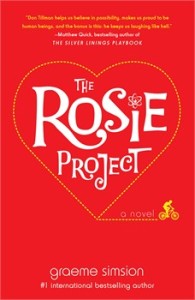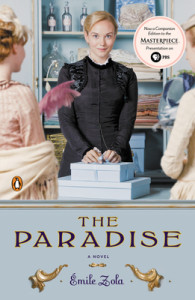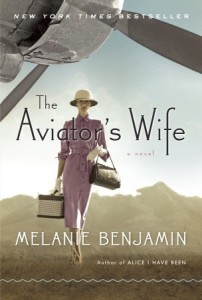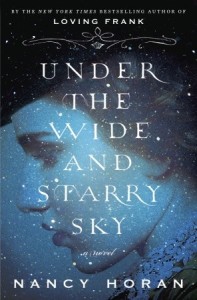 Romantic comedy set in an Australian university (present day): One of the pleasures of book blogging is the freedom to choose what to share. Taking a lesson from genetics professor Don Tillman – the thirty-nine-year-old narrator of this utterly charming and intelligent romantic comedy who dispenses with predictability and self-imposed rules – I’m expanding my definition of “beautiful prose” to include original prose.
Romantic comedy set in an Australian university (present day): One of the pleasures of book blogging is the freedom to choose what to share. Taking a lesson from genetics professor Don Tillman – the thirty-nine-year-old narrator of this utterly charming and intelligent romantic comedy who dispenses with predictability and self-imposed rules – I’m expanding my definition of “beautiful prose” to include original prose.
Owing to the “great fun” of The Rosie Project – which also delivers a poignant and meaningful message about people who are “wired differently” – I’ll hereafter allow myself to blog about novels whose prose is wonderfully original despite containing language excessively four-worded, outside my definition of beautiful. (Note: it’s part of the dialogue that fits the “barmaid” stereotype and disillusioned persona of Rosie.) The rest of this modern-day novel’s prose is consistently funny, the kind of laugh-out-loud humor that takes talent. We’re talking pitch-perfect nerdy language that befits a professor of science whose brain thinks literally, unconventionally. (For instance, instead of visiting a shop to rent a tuxedo, our lovable Don visits a “formal costume rental establishment” for “maximum formality”). Interestingly, and inspirationally, this is IT consultant Graeme Simsion’s debut novel, to be published in 35 languages. The Rosie Project is that good!
For Simsion has dreamed up a timely version of When Harry Met Sally. Instead of Billy Crystal, imagine another actor (who? Sony Pictures has already optioned the script for a movie) playing a high-functioning professor with Asperger’s syndrome who doesn’t know it, in search of a “female life partner” using scientific methods. Designing a wife questionnaire, the author creates comical prose that touches on serious issues related to unethical behaviors and society’s obsession with image and appearance.
Don Tillman is lovable for many reasons. Chief among them is his ability to appreciate his skills (organizational, focus/intensity, fast learner) and accept his differences (difficulties in: being touched, picking up on social cues, empathizing). He deals well with rejection: an “expert at being laughed at.” While he doesn’t have many friends, he has two that care about him: Gene, the fifty-six-year-old psychology professor who hired him, specializes in “sexual attraction” and claims that he has an open marriage with Claudia, who happens to be Don’s therapist.
The prose is also pitch-perfect because it matches Don’s respect for efficiency. Just by listing a few examples of the efficiency of Don’s characterizations of events, people, and experiences, you’ll be able to picture what The Rosie Project is all about:
The Wife Project (of which The Rosie Project becomes a sub-set)
The Father Project (which leads to The Rosie Project). Rosie is searching for her biological father. Gene introduces her to Don (she’s not just a “barmaid”; she’s a graduate psychology student in Gene’s department), a logical choice because Don is a geneticist. Gene, of course, knows about The Wife Project.
Great Cocktail Night (in which Don has one of the best times of his life, with Rosie, posing as a “drinks waiter”): “It was surprisingly complex, and I am not a naturally dexterous person” although Don has taught himself martial arts, karate, aikido, and dancing (taught with a skeleton!), during which Don and Rosie unethically pursue the Mass DNA Collection Subproject (at a physician’s reunion. Rosie’s mother was a doctor, who told her that her biological father was one too. )
Standardized Meal System (for which Don has identified “eight major advantages”)
Late Woman: Timeliness is one among many personal traits Don values. He thinks mathematically, talks in precise minutes. He also thinks in facts, not emotions, so he describes people in terms of their age and BMI; their food preferences (vegetarian, sustainably farmed); exercised (something he’s big on); and alcohol consumer (also big on).
Don is also reflective, in an admirable, authentic way, and not afraid to make major changes in “self-improvement.” When an “unscheduled series of events” leads him to finally solve his own profound question (“Why do we focus on certain things and not others?”), the answer, he says, is “incredible.” We say so too, because the story feels so incredibly good.
In winning a beautiful copy (appealing jacket design) of The Rosie Project, I won more than a complimentary copy of a highly entertaining novel that feels as memorable as Sleepless in Seattle. (Who could play the new Tom Hanks? Tom Hanks!) “Enchanted Prose” has a bigger umbrella than previously envisioned. Now I might discover non-fiction that reads so much like fiction I’ll tell you about it too. Like Don, though, you’ll recognize it’s still me.
Happy Reading! Lorraine



